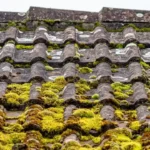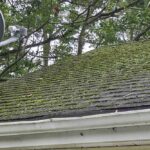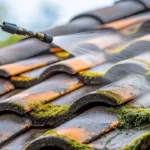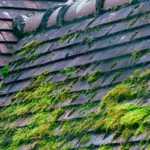The roof moss life cycle is a fascinating process that many homeowners may not fully appreciate. This article will delve into the intricacies of how moss grows on roofs, the conditions it thrives in, and the impact it can have on your home. By understanding the life cycle of roof moss, you can take informed steps to protect your home and maintain its structural integrity.

What is Roof Moss?
Moss is a small, non-vascular plant that typically grows in dense green clumps or mats. It thrives in damp, shaded environments, making the north side of a roof or under overhanging trees ideal for its growth. The presence of moss on your roof can indicate underlying issues with moisture and shade.
The Stages of the Roof Moss Life Cycle
1. Spore Dispersal
The life cycle of moss begins with the dispersal of spores. These tiny, lightweight particles can travel through the air and settle on your roof, particularly in areas where moisture collects.
2. Germination
Once the spores find a suitable environment, they germinate. This process involves the spores absorbing moisture and beginning to grow into small structures known as protonema.
3. Maturation
As the protonema develop, they eventually mature into the leafy green structures that we recognize as moss. This stage of the roof moss life cycle is when the plant begins to attach itself to the roof surface.
4. Reproduction
During the reproductive phase, moss produces sporophytes, which release spores back into the environment, continuing the cycle. This phase is crucial for the spread of moss to other areas of your roof.
Conditions Favoring Moss Growth
Moss thrives in specific conditions, including:
- Moisture: Constant moisture from rain, dew, or poor drainage.
- Shade: Limited sunlight often due to overhanging trees or buildings.
- Poor Air Circulation: Stagnant air that traps moisture.
Impact of Moss on Roofs
Moss growth on roofs can lead to several issues:
Structural Damage
As moss grows, it can lift and damage shingles, leading to water leaks and potential structural damage. Learn more about the risks at foundation risks.
Aesthetic Concerns
While some people find moss attractive, it can give a neglected appearance to a home, potentially affecting its curb appeal.
Increased Maintenance Costs
The need for regular cleaning and repairs can increase maintenance costs. Consider reading about moss removal dos and don’ts for more information.
Preventing and Managing Roof Moss
Regular Inspections
Conduct regular roof inspections to catch moss growth early and prevent extensive damage.
Trimming Overhanging Trees
By trimming trees around your home, you can reduce shade and improve air circulation, making your roof less hospitable to moss.
Professional Cleaning
For effective moss removal, consider hiring professionals. Compare DIY vs professional cleaning techniques to make an informed decision.
Using Roof Moss Inhibitors
Consider using moss inhibitors to prevent future growth. These products can help maintain a moss-free roof.
Conclusion
Understanding the roof moss life cycle is essential for maintaining a healthy and aesthetically pleasing home. By recognizing the conditions that favor moss growth, you can take preventative measures to protect your roof. For more information on managing roof moss, visit Bill Ragan Roofing.

FAQs
1. Can moss damage my roof?
Yes, moss can cause damage by lifting shingles and retaining moisture, which can lead to leaks and structural issues.
2. How can I prevent moss from growing on my roof?
Regular maintenance, trimming trees, and using moss inhibitors can help prevent moss growth.
3. Is it necessary to remove moss from my roof?
Yes, removing moss is important to prevent damage and maintain the roof’s longevity. Check out what to do after cleaning at post-cleaning tips.
This article contains affiliate links. We may earn a commission at no extra cost to you.








